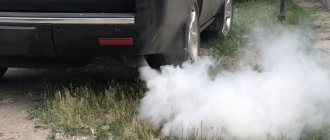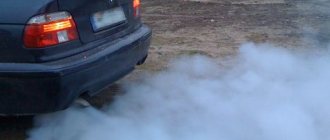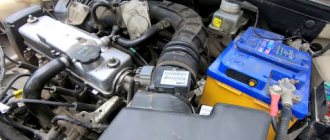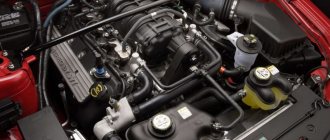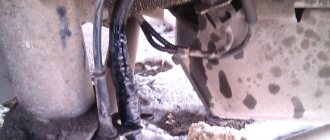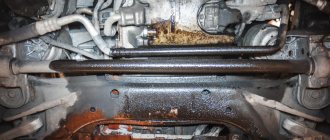string(10) “error stat” string(10) “error stat”
On Russian highways you can often see a picture when a heavily loaded truck with a diesel engine goes up a hill, literally spewing out clouds of black or blue smoke. This phenomenon is typical not only for trucks, but also for passenger cars. What does black smoke from a diesel exhaust pipe indicate? Maybe this is due to the characteristics of the engine or something else? Let's take a closer look.
Black smoke from a diesel pickup truck
Causes and methods of eliminating black smoke from the exhaust pipe of a diesel engine
The appearance of smoke in engines running on diesel fuel occurs much more often than in gasoline power units. It's all about the principle of fuel ignition. To carry out this process, the air in the diesel engine is heated to 750-800 degrees and pressure is created. In a gasoline engine, ignition occurs from the spark plug. Plus, diesel fuel requires a higher temperature to ignite than light fractions of fuel. Compared to a gasoline engine, in a diesel engine the mixture is formed in a very short time, which leads to its heterogeneity.
Do not forget: in order to burn 1 liter of fuel, up to 15 liters of air are required. Smoke indicates a malfunction of one or more systems at once. There are several reasons for this.
Elementary Watson
Ideally, the exhaust of a working diesel engine should be transparent. If a diesel engine smokes, this indicates a malfunction or malfunction of one or more engine systems. Moreover, the culprit of the increased smokiness is revealed by the color of the smoke. Looking ahead, we can say:
- gray or black smoke indicates incomplete combustion of fuel;
- bluish-blue or gray color of the exhaust indicates loss of lubricating oil and some other reasons;
- fluffy white clouds, reminiscent of a bubbler blowing out (as hookah lovers say), are actually coolant entering the combustion chambers.
So a preliminary diagnosis is determined by the color of the exhaust. A more accurate determination of the cause of smoke will be determined by specialists at a service station (STS), using diagnostic equipment and a gas analyzer. The table shows some figures regulating the maximum content of harmful substances emitted into the atmosphere. Possible malfunctions in engine systems are also indicated.
| Chemical element | Standard for diesel engine | Reason for non-compliance |
| Nitrogen (N2) | 76 — 78% | Lean fuel mixture, engine overheating |
| Oxygen (O2) | 0.5% max. | Exhaust manifold leaking |
| Carbon monoxide (CO) | 0,01 — 0,5% | Clogged filters, high fuel pressure in the power system, over-rich mixture |
| Carbon dioxide (CO2) | 1,0 — 10% | Clogged filters, excessive fuel pressure, over-rich mixture |
| Hydrocarbons (CH) | 50 PPM max. | Misfire (faulty glow plugs), rich mixture |
Air filter dirty
This element of the fuel system belongs to the category of consumables. Therefore, it must be changed on time in accordance with the instructions for the machine. However, if it is constantly used in difficult conditions, for example, with heavy dust, then the intervals between replacing the air filter should be reduced. It is especially important to prevent moisture from getting on it. If this does happen, the filter must be thoroughly dried or a new one installed.
Standard rectangular air filter
The frequency of replacing the air element is from 15 to 30 thousand km. It is recommended to change the filter along with the oil, i.e. after about 10 thousand km. The replacement process can be entrusted to specialists at a service station or you can do everything yourself: it is not difficult. Each machine attaches the filter differently: these can be bolts, screws, or plastic latches. But in most cases, the algorithm of actions is as follows:
- Place the car on a level surface, activate the handbrake, turn off the engine;
- open the hood, find the location of the filter and remove its cover;
- pull out the air element carefully so that accumulated dust and debris do not get inside the engine;
- plug the inlet pipe with a clean rag;
- using a compressor, or better yet, a vacuum cleaner, remove dust from the seat;
- remove the rags from the pipe and install a new filter;
- return the cover to its place and secure it.
If it is not possible to purchase a new product, you can clean the old one, but this is only a temporary measure: you will still have to buy a filter.
Low compression in cylinders
This parameter of engine operation can be checked at the nearest service station or done independently if you have a compression meter or compressograph. The difference between these devices is in the method of outputting information for reading. In the first case, the compression level is shown by a dial gauge. In the second, everything is displayed on a computer monitor with the ability to print out the results.
To carry out measurements correctly, certain conditions must be met. The air filter should not be clogged, the crankshaft rotation speed should be 200-250 rpm. The required compression value is indicated in the documentation for the machine.
Check progress:
- Disconnect the corresponding valves from the high pressure pump (HP pump) to stop the fuel supply;
- turn off the injection pump dispenser;
- remove the glow plug;
- Connect the measuring device to the flange;
- crank the crankshaft with the starter and at the same time take readings from the compression meter or compressor;
- take readings when the pressure stops increasing;
- test each cylinder, recording the data obtained.
Engine compression is affected by the condition of the cylinder-piston group. If the pressure is significantly different from the norm, the reason most often lies in worn parts: piston rings, pistons themselves, cylinder walls. This is often due to low quality fuel and lubricants. The situation can be corrected by boring the block in a specialized workshop. If the discrepancy between the compression and the parameters specified in the documentation is insignificant, you can use special additives.
Another reason for decreased compression is the lack of tightness of the valves. This will require disassembling the mechanism and cleaning (replacing) parts.
Recipes for treating a smoking engine
It was previously said that the fuel-air mixture in a diesel engine is more heterogeneous before ignition compared to gasoline engines. The gasoline mixture is homogeneous, which cannot be said about a sprayed cloud of diesel fuel. Therefore, even a serviceable modern diesel engine is still more prone to smoke.
What measures will help reduce the smoke of black diesel engine exhaust:
- Monitor the condition of the air filter and change the replacement filter element on time. Especially do not allow it to flood when overcoming water obstacles. If this happens, the filter must be thoroughly dried or replaced.
- Check the tightness of the air channels (hoses, clamps, intercooler). You can use a bicycle pump for this. When creating pressure in a muffled system with the engine not running, listen to see if there is any hissing of air at the connections.
- Monitor the serviceability of the high pressure fuel pump (HPFP), and if there is any suspicion, carry out bench diagnostics.
- Check the condition of the fuel injectors. Carbon deposits on the nozzle can be easily detected visually by removing the nozzle from the block head. If necessary, they should be repaired.
- If the engine jerks at idle, or dips are observed when the throttle is opened sharply, pay attention to the EGR (exhaust gas recirculation system) electromagnetic sensor.
- Check the compression in the cylinders, which you can do yourself.
- Modern diesel engines have a particulate filter that must be cleaned and washed regularly. And, of course, change it in a timely manner when it reaches the end of its service life.
Checking the functionality of the injectors
If one of them is clogged, the motor will “triple”: it’s not difficult to figure out the culprit. You need to start the engine and turn off each injector one by one. A change in the sound of a running motor indicates the normal condition of the part. If there is no response from the power unit, we can assume that the problematic spare part has been found. But if the injector overflows, then finding it will require a more complex procedure. Before testing, prepare a 20 ml disposable syringe and a transparent IV tube.
Further:
- remove the plunger from the syringe;
- start the engine and connect the syringe to the “return” of the nozzle, i.e. insert the tube into the neck of the medical instrument;
- hold the syringe for a couple of minutes until it fills with diesel fuel (if it does);
- repeat the operation for all injectors.
An empty syringe or 4-5 ml of diesel fuel in it indicates the serviceability of the part. The presence of 10-15 ml inside is a sign of its partial functionality (repair and cleaning are possible). A volume of 20 ml of fuel in the syringe indicates the need to replace the injector. The exact volume of diesel fuel that it must dump back must be indicated in the vehicle instructions.
Schematic representation of injectors
How to check the injection pump
Incorrect operation of this device may be accompanied not only by black smoke, but associated symptoms include:
- increased fuel consumption;
- unstable idling;
- problems when starting a diesel engine;
- constant overheating;
- drop in power, sluggish acceleration;
- extraneous noise during operation of the power unit.
The best option for checking the performance of the fuel injection pump is to use a stand in an auto repair center. In a garage, you can only partially check the pump:
- To check the plunger pairs of the device, remove the timing belt and slowly rotate the pulley. If you feel variable force, there is no water in the parts. If it is present, the shaft will not rotate, and the pump may jam at startup.
- The pressure in the pump is checked using the RB-4802 tester or another similar device. It is screwed in instead of the fuel pump pipe. The correct readings are 300 kg/sq.m. see, if this is not the case, replace the plunger pair.
- In an electronically controlled motor, the speed sensor may break. In this case, diesel fuel does not enter the cylinders. The sensor is checked with an ohmmeter: infinite resistance indicates a break.
- Another reason for poor fuel injection pump performance is fuel leakage. To check the assumption, start the engine and shake the axis of the device lever. If you see diesel fuel leaking, replace the rubber seal in the problem area.
Unburned fuel
This guess will be confirmed by the presence of a pungent and pungent odor from the exhaust system. This will mean that the unburned fuel comes out along with the smoke in a vapor state.
Fuel may not burn out for various reasons. It is possible that the fuel is supplied too late or that some cylinder does not cope with its task and cannot burn diesel fuel.
As a rule, every effect has causes. The consequence, in this case, is unburned fuel and, as a result, the diesel smokes blue. So what are the reasons and malfunctions in diesel components that can lead to this?
Injection pump faulty
If the cause of blue smoke is a delayed injection, then you should pay attention to the wear of the high pressure fuel pump (HPF). It is easy to guess that the fuel will not have time to burn out if it is supplied late.
So, we have decided on one of the possible culprits. But why does this happen? The design and operation of the injection pump is quite complicated. To explain in simple words, the operation of this unit is based on the movement of special mechanisms for supplying fuel, which constantly rub and contact each other.
The fuel itself serves as a lubricant for the parts. Quite a tricky solution, because diesel fuel has a greasy structure. But with the arrival of winter, a transition to winter fuel is made.
It is called winter because its viscosity is reduced, namely, those same lubricating fractions are missing or their quantity is not enough to lubricate the “hardware” in the pump. This is what causes the fuel injection pump to wear out. And the wear of this part of the unit, in turn, along with the profile of the wave washer, causes a delay in fuel injection.
The mechanism is as follows: the fuel does not have time to heat up because it is supplied late, and the cylinder begins to work poorly with surges. As a result, the fuel that does not have time to burn is released outside in the form of blue smoke.
If you warm up the engine after driving a few kilometers, the bluish trail behind the car will disappear or decrease so much that it cannot be traced. But pump problems will not be corrected by this. When the engine is warm, even fuel supplied late has time to burn almost completely due to the high temperature background.
Poor engine compression
There are times when strong blue smoke comes out when starting the engine. And then after proper warming up the smoke disappears. This picture is quite common in the courtyards of our country, when there are columns of smoke, and the driver is running, clutching his head, and cannot understand what is happening.
The reason for this is low engine compression. Due to this defect, the temperature during compression does not reach the required value, so the fuel does not burn out completely. Even if the engine has one cylinder with low compression, the operation of such an engine is possible. But it will smoke until the overall temperature rises and the faulty cylinder begins to cope with the incoming fuel and ignite it.
Problems with the turbocharger (turbine)
Its faults can be identified independently, without removing the unit from the machine. In addition to the appearance of black (gray) smoke from the exhaust pipe, problems with the turbocharger are indicated by:
- excessively noisy engine operation under load;
- constant overheating;
- reduction of power unit traction and dynamics;
- increase in fuel consumption.
You can check the turbine's performance by ear and visually. A normally functioning unit should not creak, hiss or whistle. Check the tightness of the pipe connections and the condition of the air filter. To make sure that there is no wear on the device, turn its rotor: it should not touch the body (play of no more than 0.05 mm is allowed).
There are also unexpected reasons when the engine smoke is increased. The “culprit” may be the ignition system control solenoid valve, which looks like a small bolt. Sometimes it is enough to hit it so that the engine stops smoking: the correct ignition angle is restored.
If blue (grey) smoke comes out of the exhaust pipe
There are several reasons for this phenomenon: improper formation of the fuel torch, “uncomfortable” conditions for ignition of the fuel. The causes of blue smoke from a diesel exhaust pipe may be related to oil. When it gets into diesel fuel, the viscosity drops sharply. This results in the lubricant being unable to withstand friction. Identifying the problem of blue smoke is not difficult; to do this, you need to pull out the dipstick. If oil drips from it and you smell fuel, engine diagnostics and repairs are necessary. Oil can enter the combustion chamber in several ways:
- through worn oil scraper rings when they are stuck or worn out;
- through bad turbocharger bearing seals;
- from the air filter if the crankcase ventilation does not work (clogged).
Blue smoke from the exhaust pipe of a diesel engine can appear when the fuel stream is ineffective, when the diesel fuel does not burn completely and comes out of the muffler. It gives the smoke a bluish tint. But there is another danger here: the mixture begins to burn at the bottom of the piston, and not in the chamber; as a result, the part experiences enormous loads, which leads to scuffing on the cylinder walls. A diesel engine produces blue smoke even when the fuel is poorly ignited, which is associated with wear of the CPG elements, low compression, and faulty glow plugs. Except for the last case, there is only one way out - a major overhaul of the power plant.
Blue smoke from engine
Differences between white smoke and water vapor
Thick white smoke from water vapor is also not a sign of normal operation. The first time after starting a cold diesel engine, condensation begins to release, both from water vapor contained in the exhaust gases and from moisture residues inside the pipelines and exhaust mufflers. But the intensity of the smoke is not alarming, and after warming up the gases become transparent.
On the subject: Checking diesel engine injectors, ways to clean them at home
If this does not happen, then you need to check what exactly forms the white color. Unburned finely atomized diesel fuel is difficult to distinguish visually from water vapor, but by smell they are completely different substances. And the second sign is the rate of evaporation of condensate from a white paper sheet brought to the exhaust pipe.
Water leaves quickly, but diesel fuel leaves traces of oil and quickly spreads over the porous structure, having a significantly higher penetrating ability.
Pure white smoke from diesel fuel appears only in the most advanced cases, for example, when the fuel does not burn at all in one of the cylinders. During partial combustion, free carbon (soot) is formed, and the gases take on a gray tint.
Why does diesel smoke white?
Thick, light exhaust indicates the presence of water (coolant - antifreeze) in the combustion chamber.
She can get there in different ways:
- cylinder head gasket is torn;
- The throttle cooling pipe has failed.
To determine the cause of white smoke from the exhaust pipe of a diesel engine, look into the expansion tank. If the above versions are correct, you will see the oiliness of the liquid in the container, its low level and the smell of exhaust gases. When you remove the crankcase, instead of oil there will be an incomprehensible liquid there. To solve the problem, you will need to install a new gasket and/or replace the pipe. But don’t panic if the diesel engine smokes when cold and then stops: this is normal.
White smoke from engine
Common causes of smoke
As you know, the fuel-air mixture burns in the engine cylinders. The fuel enters here through the injector nozzles and “meets” the air, which is supplied through the intake manifold. The cylinder pistons create the pressure necessary to mix air with fuel. When the entire system works like a clock, the mixture burns almost completely, and the emission of hydrocarbons into the atmosphere is minimal. The smoke that comes out of the exhaust pipe when the engine starts is the result of incomplete combustion of the fuel mixture for various reasons:
- The injection advance angle is off.
- Uneven fuel spray.
- Insufficient air supply to the cylinder block.
- Fuel is of low quality, with a high concentration of sulfur.
Let us immediately note that it is impossible to find out the exact cause of the breakdown only by the type of exhaust. The color of the smoke will tell you where to look for a problem (cooling system, compressor, etc.), which will save time. But an accurate “diagnosis” will only be made by a complete diagnosis of all systems, which is best not to delay.
Consequences of ignoring the problem
The most unfortunate result is engine jamming and subsequent major repairs. A less complex, but also unpleasant consequence is a reduction in the service life of the power unit. Therefore, it is easier and cheaper to identify a faulty unit or part in a timely manner and repair or replace it. For example, when a particulate filter becomes clogged, dirt begins to get into the lubricant, causing the oil line to become clogged.
As a result, the motor parts begin to overheat and work under increased load, which leads to a reduction in the service life of the motor. In the worst case, valves and pistons burn out.
The appearance of smoke of any shade from the exhaust pipe does not mean that major repairs are immediately required. This is just a serious signal that cannot be ignored, so as not to “run into” an expensive restoration of the power unit at a car service center. It is recommended to stop using the car as soon as possible and to diagnose the engine condition at the initial stage.
If you have any questions, leave them in the comments below the article. We or our visitors will be happy to answer them
Application of anti-haze additives
Numerous chemical additives from different brands can reduce oil consumption. Their action is to form a protective film on the surface of rubbing parts. This film fills all microcracks on the surface, protecting the part from premature wear. The use of such additives replaces such a procedure as decoking of piston rings. But are chemicals really effective or is it all just marketing?
Anti-smoke additives
Experts on automotive forums express conflicting opinions about the use of special additives. Experienced auto mechanics are confident that regular use of chemicals leads to the appearance of a dense oil layer on the surface of parts, which is difficult to wash off. All this complicates engine overhaul, because many parts that cannot be cleaned have to be replaced. This significantly increases the cost of repairs.
The use of special additives for the motor
Important! Additives will only help to slightly extend the life of the engine, but they do not provide any guarantees for its trouble-free operation.
Anti-smoke - anti-smoke additive

